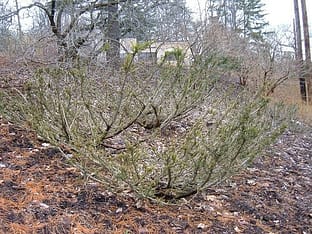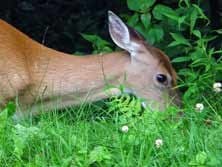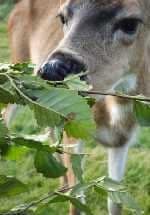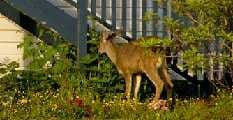These deer control tips are important to know before starting a deer control programs.
If you are selling professional deer control, these are the first basic tips you should know.
First make sure it is deer damage and not damage from another animal.
Look at tracks and plants damaged by deer. Learn to tell the difference between animal damage to plants.
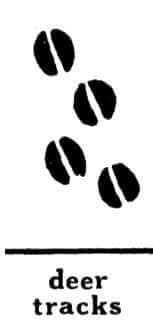

You see deer in your yard and/or have to slow down regularly in your car so that you don't hit a deer. If you are seeing them, the population is high enough to threaten your plants. The best time to see deer are around dusk and dark.
Start early in Spring - Protect your plants early. Start spraying deer repellent in early Spring and continue through Fall. Most deer repellents need to be reapplied every 2-3 months at least. You should reapply as needed to new growth since it is the deer's favorite part. Put on your repellent before deer start coming around and doing damage. It is much easier to deter them if they haven't already been eating there.
Change it up - Deer become accustomed to tastes or smells. Rather than just changing the brand of deer repellent you're using, identify what the active ingredient is. Then, change the active ingredient. Some competing brands may use the same active ingredient, yet in different strengths. Rotate your repellent and ingredients every season.
Multi-Faceted Approach - When possible, try to affect as many senses of the deer as possible. Sight, sound, smell, and taste are all vulnerable areas of our four-legged friends. Targeting two of the senses at the same time will make it that much more intimidating to the deer. That's why we suggest using a deer repellent spray or powder in combination with deer resistant plants and maybe even a temporary fence, a scarecrow, a radio, wireless deer fence, pans, water spray, or even a dog.
Vegetables and Fruits or Landscape Plants -Repellent for shrubs and flowers can contain a bitter ingredient which can't be used on edible plants. Some repellent also contain latex to help the repellent stick. Make sure and read the label carefully and only use those repellent recommended for edible food on your crop plants. To be safe you can make your own repellent.
Deer Tracks - Deer leave deer tracks that distinctive hoof prints. The deer tracks are shaped like broken hearts and are about 2-3 inches long. Running deer leave tracks much farther apart than deer walking or grazing. Be aware however that there are other animals that leave similar tracks. Elk, cattle, llamas, and goats all have similar tracks, but obviously if you don't have any of those other animals in your neighborhood, the suspects are narrowed down considerably.
Deer Damage Torn Foliage and Twigs vs. Clean Cut - Deer have no front incisor teeth so they strip bark by raking their incisors upward, making two-inch gouges. When they eat foliage, they tear it off, leaving ragged edges and surfaces on twigs, stems, and leaves. Deer damage will look random and ragged. Rabbits,rodents, and woodchucks, leave a clean-cut edge. If you cut branches off with a knive or saw, this animal damage would look the same. A rodent will leave a clean cut, usually angled. It looks like someone cut the plants with hand shears and angled the cut.
Deer Damage Clue - Damage Height - Rodents eat lower parts of trees, up to the height they can reach standing on their hind legs, which is much lower than deer damage. Deer will also eat plants up the level they can reach on their hind feet, so the height at which plants are damaged should eleminate most other suspects.
Time of Day - Deer are most active just after dusk and just before dawn. If your damage is being done in the daytime, look around your area for daytime feeders like goats or sheep. Sometimes even dogs will eat some plants. You might want to invest in a wildlife camera for less than $100 and get some pictures of what is going on around your property on a 24 hour basis.
Deer Scat - Scat, also called deer droppings, is a calling card that you will also find around deer damage. In the winter months when deer are mostly eating twigs and leaves, the droppings will be small elongated pellets. In the spring and summer months when deer are feeding on lush green shoots, leaves, grass, fruit, etc, the pellets clump together and are left as a mass. Droppings that are still shiny are from less than a day ago. Dull droppings may be days old.
Rabbit droppings may be mistaken for deer droppings, but are smaller andperfectly round. Goat and sheep droppings are more elongated. Skunks, raccoons, and opossums leave droppings like a dog.



